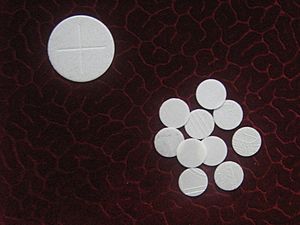Unleavened bread facts for kids

|
|
| Type | Bread (usually flat bread) |
|---|---|
| Variations | Matzo, roti, tortilla, and many others |
Unleavened bread is a type of bread made without anything that makes it rise, like yeast. Most unleavened breads are flat breads. However, not all flat breads are unleavened. Unleavened breads, like the tortilla and roti, are important foods in places like Central America and South Asia. A special kind of unleavened bread is also very important in Christian church services.
Why is Unleavened Bread Special?

Unleavened breads have a special meaning in Judaism and Christianity. Jewish people eat unleavened bread called matzo during Passover. Christians use unleavened bread for the Eucharist, also known as Holy Communion. This tradition comes from a command in the Bible, in Exodus 12:18.
The Torah (which is part of the Old Testament) tells a story about the Israelites. They had just become free from Egypt and had to leave very quickly. They didn't even have time for their bread to rise! So, they ate bread that was flat. Eating unleavened bread today reminds people of this fast departure.
In the Latin Church of the Catholic Church, church rules say that only unleavened bread must be used for the special bread (called the Host) and wafers given to people during communion. Some Protestant churches also use unleavened bread or wafers. Others might use regular bread that has risen, depending on their church's traditions.
However, most Eastern Churches do not allow unleavened bread for the Eucharist. They believe that bread with yeast is a symbol of the New Covenant in Christ. This difference in using unleavened bread was one of the main reasons for a big split in the church in 1054. This event is known as the Great Schism between the Eastern and Western churches.
Different Kinds of Unleavened Bread
There are many types of unleavened bread eaten around the world. Here are a few examples:
- Arboud - This bread is made from wheat flour and baked in the hot ashes of a campfire. It's a traditional bread for Arab Bedouin people.
- Arepa - Made from corn and corn flour, arepas come from Colombia and Venezuela.
- Bannock - This unleavened bread started in the British Isles.
- Bataw - A traditional bread from Egypt, made from barley, corn, or wheat.
- Kitcha - An Ethiopian flat bread. It is often used in dishes like fit-fit or chechebsa.
- Lavash - This Armenian flat bread is usually made with yeast, but sometimes it is unleavened. It is recognized by UNESCO for its cultural importance.
- Matzo - A well-known Jewish flat bread.
- Piadina - From the Romagna region of Italy, this bread is made with wheat flour, lard or olive oil, water, and salt.
- Rieska - A traditional unleavened bread from northern Finland, usually made with barley.
- Roti - Many Indian flat breads are called roti, including Chapati and Dalpuri.
- Tortilla - A flat bread from Mesoamerica and Mexico, often made from corn or wheat.
- Tortilla de rescoldo - A Chilean unleavened bread made from wheat flour. It is traditionally baked in the coals of a campfire.
See also
 In Spanish: Pan ácimo para niños
In Spanish: Pan ácimo para niños

